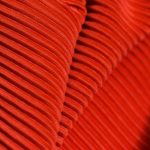When you weave corduroy, you create fabric with soft, raised ridges called wales by weaving extra yarn sets and cutting them to form those signature vertical ribs. You’ll want durable, breathable cotton or cotton blends and specialized tools like looms with pile warp beams and sturdy beaters to keep the pile uniform and plush. Proper yarn thickness and tension are key to texture and strength. Stick around to discover how to perfect this plush fabric and keep it looking great.
Table of Contents
Key Takeaways
- Corduroy fabric features raised vertical ridges called wales, created by weaving extra yarn sets and cutting them to form soft pile.
- Cotton yarns are preferred for comfort and breathability, while polyester blends enhance durability and wear resistance in corduroy weaving.
- Essential tools include a loom, shuttle, warp beam, reed, and heddles to properly position and weave the warp and weft threads.
- Specialized equipment like pile warp beams, pile wires, and reinforced reeds ensure consistent pile texture and fabric softness.
- Proper care involves gentle washing inside out, mild detergents, air drying, and soft brushing to maintain corduroy’s texture and vibrancy.
Understanding the Structure of Corduroy Fabric
Corduroy’s distinctive texture comes from its unique weave structure, which combines raised ridges called wales with a plain weave base.
When you look closely, those wales are actually formed by extra sets of yarns woven into the fabric, then cut to create soft, vertical ridges. This technique gives corduroy its characteristic plush feel and durability.
The spacing and number of wales per inch can vary, affecting the fabric’s appearance and weight. You’ll find fine-wale corduroy more delicate, while wide-wale versions feel chunkier and more rugged.
Understanding this structure helps you appreciate why corduroy is both comfortable and hard-wearing. By focusing on the interplay between the wales and base weave, you grasp what makes corduroy a unique and versatile fabric choice.
Selecting the Right Yarn for Corduroy Weaving
The unique texture of corduroy depends heavily on the yarns chosen for weaving. When selecting yarn, prioritize durability and softness to achieve that signature plush feel.
Cotton yarns are popular for their breathability and comfort, while blends with polyester add strength and resistance to wear. Consider the yarn’s thickness; thicker yarns create deeper, more pronounced wales, while finer yarns result in a smoother finish.
Don’t overlook the twist of the yarn—tightly twisted yarns produce a firmer fabric, whereas loosely spun yarns offer more softness. Also, think about colorfastness to guarantee your fabric maintains its vibrant look after washing.
Essential Tools and Equipment for Weaving Corduroy
To weave corduroy effectively, you need both basic weaving tools and specialized equipment designed for this fabric’s unique texture.
You’ll want to get familiar with items like looms, shuttles, and reed, plus tools that help create the distinctive ribs of corduroy.
Let’s explore the essential gear that will make your weaving process smoother and more precise.
Basic Weaving Tools
Mastering corduroy weaving requires having the right tools on hand. You’ll need basic weaving equipment to create the fabric’s signature ribbed texture effectively. These tools help you manage threads, maintain tension, and weave consistently.
| Tool | Purpose |
|---|---|
| Loom | Holds warp threads in place |
| Shuttle | Carries weft thread through warp |
| Warp Beam | Holds and controls warp tension |
| Reed | Spaces warp threads evenly |
| Heddles | Lift warp threads for pattern |
Each tool plays an essential role in ensuring your corduroy fabric has the correct structure and durability. By familiarizing yourself with these basics, you’ll build a solid foundation before moving on to more specialized corduroy equipment.
Specialized Corduroy Equipment
Once you’ve gathered the basic weaving tools, it’s time to focus on equipment designed specifically for corduroy’s unique texture. You’ll need a specialized reed and heddles that accommodate the thicker, raised pile yarns to maintain the fabric’s signature ribs.
A pile warp beam is essential—it helps control the extra yarn tension and keeps the pile loops consistent. Using a pile wire or a specially designed wire hook allows you to lift and separate the pile yarns evenly as you weave.
Additionally, a sturdy beater with adjustable pressure guarantees the ribs pack tightly without flattening. These tools work together to create corduroy’s distinctive ridges while preserving softness and durability.
Investing in this specialized equipment will make your weaving process smoother and your finished fabric professional.
Step-by-Step Process of Weaving Corduroy
Creating corduroy fabric involves a careful sequence of weaving techniques that give it its distinctive ridged texture.
You start by preparing the warp threads, arranging them tightly on the loom. Next, you weave a base fabric using a plain or twill weave to form the foundation.
Then, you insert extra sets of filling yarns called pile yarns, which create raised loops on the surface. Finally, you cut these loops to form the soft, velvety ribs characteristic of corduroy.
Here’s the process in steps:
- Set up warp threads tightly on the loom.
- Weave a base fabric using plain or twill weave.
- Add extra filling yarns to form loops.
- Cut loops to reveal the ribbed pile texture.
You’ll see how each step builds the unique corduroy surface.
Tips for Achieving the Perfect Corduroy Pile
To achieve the perfect corduroy pile, you need to focus on maintaining uniform pile height and density throughout the fabric.
Selecting the right weaving techniques plays an essential role in creating consistent ribs and texture.
Let’s explore how these factors work together to give your corduroy that flawless finish.
Maintaining Pile Uniformity
Although maintaining pile uniformity can be challenging, you’ll find that consistent tension and careful brushing are key to achieving the perfect corduroy pile.
To keep your fabric’s ribs even and smooth, follow these essential steps:
- Monitor tension constantly during weaving to prevent loose or tight sections.
- Use a soft brush regularly to lift and align the pile fibers gently.
- Avoid excessive pressure on the fabric to prevent crushing the pile.
- Inspect your fabric frequently, correcting any uneven areas before continuing.
Choosing Appropriate Weaving Techniques
Maintaining pile uniformity sets a strong foundation, but selecting the right weaving techniques will truly determine the quality of your corduroy pile. You’ll want to focus on the rib structure, typically achieved through a weft-faced weaving method that allows for distinct wales.
Using a tight weave guarantees the pile stands upright and feels plush. Consider employing a double cloth technique, which can enhance pile density and durability.
Pay attention to the tension during weaving; uneven tension can cause pile distortion or irregular ribs. Also, choose the right loom settings to control pile height precisely.
Caring for and Maintaining Your Corduroy Creations
Because corduroy’s unique texture can trap dirt and wear unevenly, you’ll want to handle your creations with care to keep them looking their best.
Start by washing corduroy inside out on a gentle cycle to protect the pile. Avoid harsh detergents; instead, use mild soap to preserve fabric integrity.
After washing, lay your piece flat or hang it to dry, steering clear of high heat that can crush the ribs.
Finally, maintain the texture by brushing the fabric gently with a soft-bristled brush to lift the pile.
- Turn garments inside out before washing
- Use mild detergent and cold water
- Air dry flat or hang; avoid heat
- Brush gently to revive pile texture
This routine helps your corduroy creations stay vibrant and soft.
Frequently Asked Questions
Can Corduroy Be Woven on a Standard Loom or Is a Special Loom Required?
You can weave corduroy on a standard loom, but you’ll need to add extra steps to create its distinctive raised ribs. While a special loom isn’t required, careful technique is essential to achieve that textured pile.
What Historical Periods Popularized Corduroy Fabric?
Imagine corduroy as a sturdy knight, rising through medieval times and marching boldly into the Industrial Revolution. You’ll find it popular in Victorian England and resurging during 1970s fashion, symbolizing resilience and comfort across eras.
Are There Eco-Friendly Yarn Options Suitable for Corduroy Weaving?
You can choose eco-friendly yarn options like organic cotton, recycled polyester, and hemp for weaving corduroy. These sustainable fibers reduce environmental impact while maintaining durability and texture, making your fabric both stylish and responsible.
How Does Corduroy Fabric Compare to Velvet in Texture and Use?
You’ll find corduroy has a ribbed, durable texture, perfect for casual wear and upholstery. Velvet feels smoother and more luxurious, ideal for formal clothing and decor. Both add warmth but serve different style needs.
Can Corduroy Be Combined With Other Fabrics in Weaving Projects?
You can absolutely combine corduroy with other fabrics—it’s like a fashion superhero teaming up! Mixing textures adds depth and flair to your weaving projects, making your creations stand out boldly and uniquely every single time.
- Does Chiffon Fabric Stink - July 15, 2025
- Does Chiffon Fabric Affect the Economy - July 15, 2025
- Does Cotton Fabric Have a Nap - July 15, 2025







